Physical Address
304 North Cardinal St.
Dorchester Center, MA 02124
The clinical and radiologic features of craniosynostosis result from lack of sutural formation or premature fusion across membranous sutures. The premature sutural closure prevalence is displayed in e-Table 20.1 . Normal sutures permit skull growth perpendicular to their long axes. With early closure of one suture, there is compensation and excess growth in others resulting in a craniofacial deformity ( e-Table 20.2 ; e-Fig. 20.1 and Figs. 20.2–20.4 ).
| Suture | No. per 1 Million Live Births | Sporadic (%) | Male/Female Ratio | % of Total | Comment |
|---|---|---|---|---|---|
| Sagittal | 190 | 72 | 3.5 : 1 | 56 | |
| Coronal | 94 | 61 | 1 : 2 | 26 | Bilateral > unilateral |
| Multiple | — | — | — | 14 | |
| Metopic | 67 | — | 3.3 : 1 | 4 | |
| Lambdoid | — | — | — | <1 |
| Suture | Calvarial Configuration | Descriptive Terms |
|---|---|---|
| Sagittal | Long, narrow head | Scaphocephaly or dolichocephaly |
| Bilateral coronal | Short, wide head; hypertelorism; proptosis; small anterior fossa | Brachycephaly or bradycephaly |
| Metopic | Frontal wedging or keel-shaped head | Trigonocephaly |
| Bilateral lambdoid | Shallow posterior fossa, prominent bregma | Turricephaly |
| Unilateral coronal | Unilateral frontal flattening, uptilting of orbit and tilting of nasal septum | Plagiocephaly |
| Unilateral lambdoid | Unilateral posterior flattening | Plagiocephaly |
| All sutures | Small, round head | Microcephaly |
Calvarial deformities present before sutural changes. Only a portion of the bony suture needs to be closed to have craniosynostosis ( e-Fig. 20.5 ). Abnormal head shape secondary to suture maldevelopment can present in utero at 13 weeks' gestational age. Craniosynostosis is associated with genetic abnormalities ( e-Box 20.1 ) and is a secondary finding in many systemic disorders ( e-Box 20.2 ).
FGFR1
Pfeiffer syndrome
FGFR2
Apert syndrome
Pfeiffer syndrome
Crouzon syndrome
Jackson-Weiss syndrome
Beare-Stevenson cutis gyrata syndrome
Nonclassifiable and variable craniosynostosis
FGFR3
Thanatophoric dysplasia, type I
Thanatophoric dysplasia, type II
Crouzonodermoskeletal syndrome
FGFR3 -associated coronal synostosis syndrome (Muenke craniosynostosis)
TWIST
Saethre-Chotzen syndrome
MSX2
Boston-type craniosynostosis
Metabolic disorders
Hyperthyroidism
Rickets (various forms)
Mucopolysaccharidoses and related disorders
Hurler syndrome
Morquio syndrome
β-glucuronidase deficiency
Mucolipidosis III
α-mannosidase deficiency
Hematologic disorders
Thalassemia
Sickle cell anemia
Polycythemia vera
Congenital hemolytic icterus
Teratogens
Diphenylhydantoin
Retinoids
Valproate
Aminopterin
Fluconazole
Cyclophosphamide
Malformations
Holoprosencephaly
Microcephaly
Encephalocele
Iatrogenic disorders
Hydrocephalus with shunt
Atrophy of brain
Specific head shapes are associated with particular suture synostoses ( e-Fig. 20.6 ). The normal head is oval, being widest in the parietal area with a rounded forehead ( Fig. 20.7 ).
Sagittal synostosis (scaphocephaly or dolichocephaly) is characterized by increased AP skull length, decreased width, bitemporal pinching, and a tendency for the vertex to be anterior rather than posterior (see Figs. 20.3 and 20.4 ). Metopic synostosis (trigonocephaly) results in a triangular, pointed forehead ( Fig. 20.8A-C and e-Fig. 20.9 , also see e-Fig. 20.6 ). The premature fusion of the metopic suture often results in what has been termed the “omega” sign as opposed to the normal “M” sign present in normal physiologic fusion of the metopic suture ( Fig. 20.8D and E ).
Unilateral coronal synostosis results in flattening of the ipsilateral forehead and occipital area, a “harlequin eye” (the sphenoid is drawn up toward the closed suture), contralateral forehead bossing, and deviation of the nose away from the synostosed side ( Fig. 20.10 and e-Fig. 20.11 ). Features distinguishing unicoronal synostosis from anterior deformational plagiocephaly are listed in e-Table 20.3 .
| Features | Synostotic | Deformational |
|---|---|---|
| Ipsilateral superior orbital rim | Up | Down |
| Ipsilateral ear | Anterior, high | Posterior, low |
| Nasal root | Ipsilateral | Midline |
| Ipsilateral malar eminence | Forward | Backward |
| Chin deviation | Contralateral | Ipsilateral |
| Ipsilateral palpebral fissure | Wide, low | Narrow, high |
| Anterior fontanel deviation | Contralateral | None |
Bicoronal synostosis causes brachycephaly (i.e., wide, short head). The supraorbital rims and forehead are recessed with bitemporal and forehead bulging ( Fig. 20.12 and e-Fig. 20.13 ).
Lambdoid synostosis results in ipsilateral occipital flattening and elongation along the axis of the synostosed lambdoid with contralateral superior parietal bulge ( Fig. 20.14 and e-Fig. 20.15 ). The features differentiating unilateral lambdoid synostosis from deformational plagiocephaly are listed in e-Table 20.4 .
| Features | Synostotic | Deformational |
|---|---|---|
| Contralateral posterior bossing | Parieto-occipital | Occipital |
| Forehead | Contralateral frontal bossing | Ipsilateral frontal bossing |
| Ipsilateral occipitomastoid bossing | Present | Absent |
| Ipsilateral ear | Anterior, anteroinferior, posterior, or symmetric | Anterior |
| Skull base and face | Ipsilateral inferior tilt | Normal * |
| Head shape, vertex view | Trapezoid-shaped or parallelogram-shaped depending on severity | Parallelogram |
| Head shape, posterior view | Parallelogram | Normal |
| Lambdoid suture | Unilateral synostosis † | Patent suture |
† Bulges at inferior and superior axes of location where suture should be.
Multiple suture synostosis occurs in 14% of cases, and the head shape depends on which sutures are closed. The Kleeblattschädel , or cloverleaf skull anomaly, occurs when all sutures except the squamosal are closed resulting in severe temporal and vertex bulging ( Fig. 20.16 and e-Fig. 20.17 ). Isolated synostosis of the squamosal and skull base sutures can also occur particularly in syndromic cases.
Microcrania, or a small cranium, may result when all sutures are closed. This usually occurs with failure of brain growth. Rarely, it occurs without failure of brain growth, and increased intracranial pressure may develop ( Fig. 20.18 ).
Cranial deformities mimicking synostosis may result from static forces such as intrauterine crowding or prolonged recumbency. The term plagiocephaly refers to flattening of the calvarium without denoting an etiology and is preceded by terms that describe the location (e.g., right posterior plagiocephaly). Postnatal deformational plagiocephaly primarily affects the forehead or occipital area. Since the 1993 American Academy of Pediatrics recommendation to put infants to sleep on their backs, occipital deformational plagiocephaly cases have increased ( Fig. 20.19 ). The ipsilateral occiput and contralateral forehead are flattened. Malposition of the ipsilateral pinna, protrusion of the ipsilateral cheek, and compensatory bulging of the ipsilateral forehead and contralateral occipital area are noted. Viewed from above, the head has a parallelogram shape ( Fig. 20.20 ).
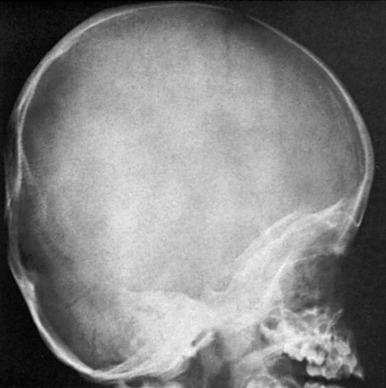
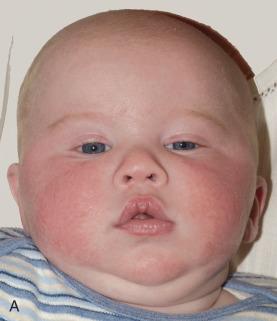
Perisutural lambdoid sclerosis may be seen on a plain radiograph; however, the suture is open. The concept of a “sticky lambdoid suture” is no longer considered valid. Plagiocephaly also may occur with bony, muscular, or ocular torticollis.
In deformational plagiocephaly, the skull base (i.e., aligned from the crista galli through the foramen magnum) remains straight, with less than 7 degrees' angulation, whereas in unilateral coronal or lambdoid synostosis, the skull base curves (see Figs. 20.20 and 20.21 ). Pseudoscaphocephaly occurs when premature infants lie on the sides of their heads in the neonatal intensive care unit. Although the head is long and narrow, the sagittal suture is open.
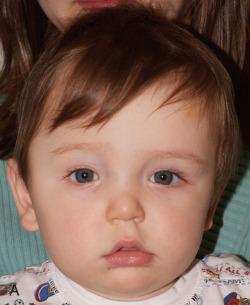
Radiographic examination of the skull consists of anteroposterior or Caldwell, Towne, and both lateral views. The sagittal, coronal, and lambdoid sutures are all normally identified. The anterior fontanel is visible at least until 7 months of age. Although the metopic suture closes any time from before birth to after 3 months of age, as many as 10% remain open into adulthood. The same head deformity results from partial and total suture synostosis (see e-Fig. 20.5 ). The key findings to diagnosis craniosynostosis are (1) abnormal head shape and (2) suture obliteration.
Cranial restructuring techniques have focused on (1) release of sutural synostosis, (2) cranial remodeling, (3) reduction of abnormal skull expansion, and (4) expansion of abnormally narrow areas.
In most instances, three-dimensional (3D) computed tomography (CT) is required to plan for cranial restructuring. Radiation dose can be lowered to 65 mA and 80 kV at 0.5 second with a slice thickness of 1.25 mm and a CT dose index “dose” of approximately 2.37 mGy. Images are reconfigured to 0.625 mm for various reconstructions ( Figs. 20.22–20.24 and e-Fig. 20.25 ).
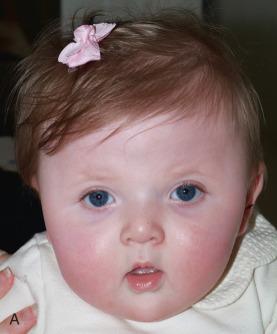
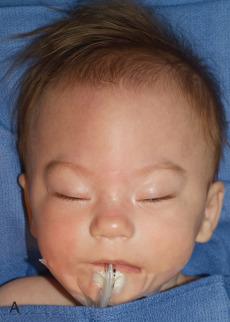
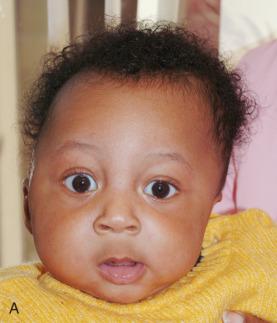
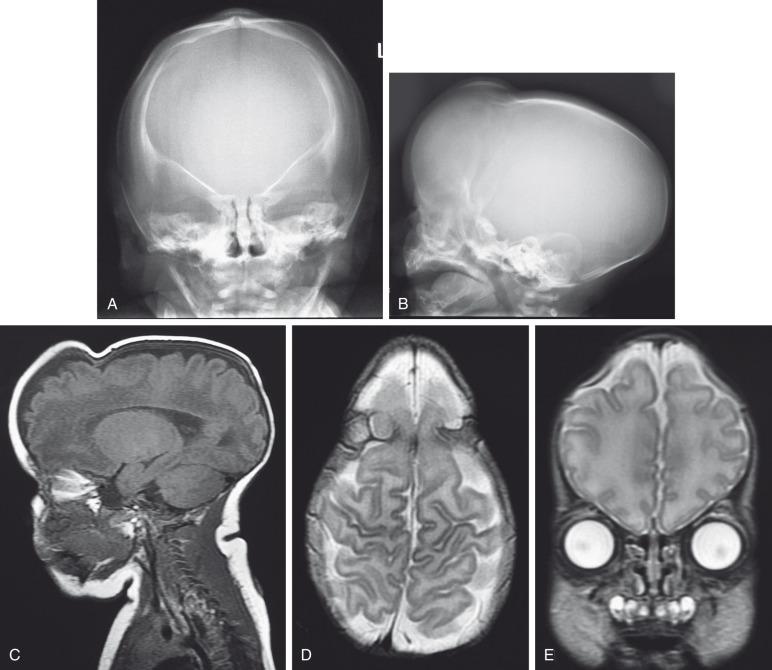
Magnetic resonance imaging (MRI) is not well suited for identifying cranial sutures. However, a recently reported gradient echo sequence has been used to minimize soft tissue contrast allowing the cranial sutures to be hyperintense against the signal void of the cranial bones. In syndromic children, brain MRI is performed for developmental anomalies.
While there are reports of successfully using ultrasound for diagnosing synostosis, this has not gained widespread acceptance and, if positive, requires further imaging to be performed.
Limb defects are the most common anomalies associated with craniosynostosis, occurring in up to 84%. Syndactyly and polysyndactyly constitute 30% of the limb defects, and deficiencies account for 22%.
Several types of acrocephalosyndactyly and acrocephalopolysyndactyly have been described. Some are clearly defined; others are less clear and may undergo reclassification as further information becomes available.
The best-known acrocephalosyndactyly is Apert syndrome (acrocephalosyndactyly type I), in which bicoronal synostosis is associated with symmetric syndactyly of the second, third, and fourth digits, resulting in the “mitten or paddle hand” ( e-Fig. 20.26 ). Developmental delay is variably present. Evaluation of craniofacial deformities may be assisted by CT ( e-Fig. 20.27 , Fig. 20.28 , and e-Fig. 20.29 ).
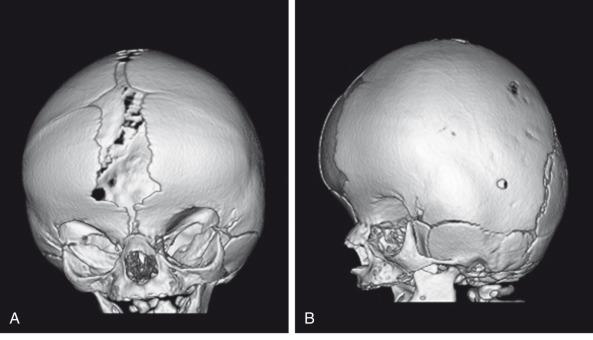
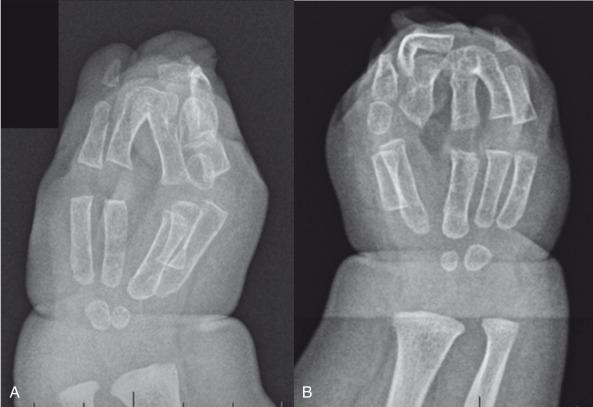
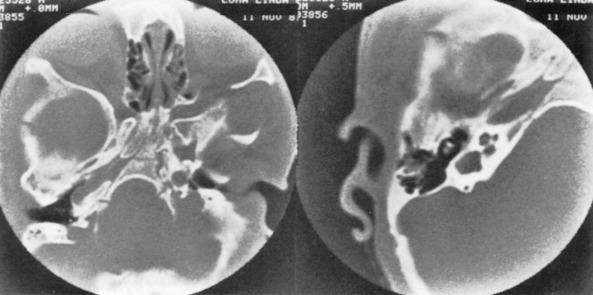
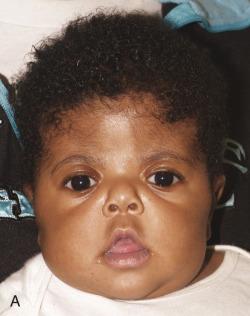
Acrocephalosyndactyly types II, III, and IV are known as Apert-Crouzon disease , Saethre-Chotzen syndrome , and Waardenburg syndrome , respectively; they involve varying degrees of facial abnormality and syndactylies in patterns particular for each type. Acrocephalosyndactyly type V, Pfeiffer syndrome , has only moderate soft tissue syndactyly, but the thumbs and great toes are deformed and broad ( Fig. 20.30 ).
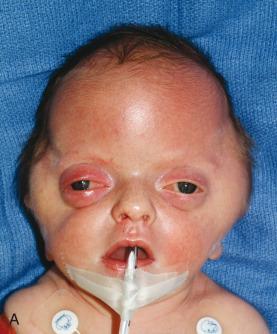
Carpenter syndrome (acrocephalopolysyndactyly type II) is characterized by developmental delay and preaxial polydactyly of the feet. Types I and III are known as Noack syndrome and Sakati-Nyhan syndrome .
In Crouzon syndrome , the cardinal elements originally included (1) brachycephaly, (2) facial dysostosis with a hooked parrot nose and small maxilla, (3) bilateral exophthalmos, and (4) genetic transmission and familial incidence ( e-Fig. 20.31 and Fig. 20.32 ).
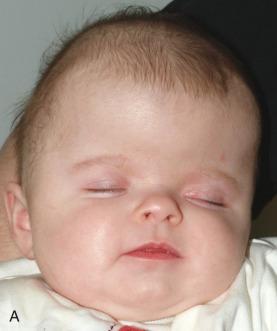
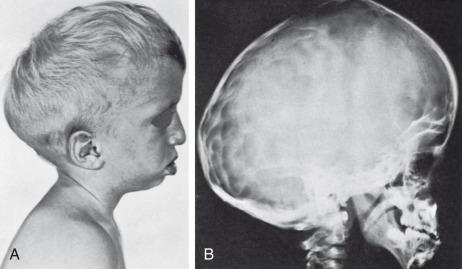
The complications of these syndromes include exophthalmos, loss of vision, increased intracranial pressure, and developmental delay. Maxillary hypoplasia may cause upper airway obstruction and sleep apnea. Surgical procedures are performed to improve the airway, dental occlusion, and deformities.
Kleeblattschädel (cloverleaf skull) results from closure of all sutures except the squamosal sutures, leading to severe temporal and vertex bulging with exophthalmos (see Fig. 20.16 and e-Fig. 20.17 ). Hydrocephalus develops in utero, deforming the skull into a superiorly elongated calvarium with dilated frontal and temporal regions. Most patients do not survive infancy (see Fig. 20.16 ). Kleeblattschädel may be found in thanatophoric dysplasia type II.
A large number of conditions fall under the category of craniofacial syndromes; most are uncommon and beyond the scope of this book. Four of the relatively more common syndromes are discussed: Goldenhar, hemifacial microsomia, Treacher Collins, and Pierre Robin sequence (PRS).
Become a Clinical Tree membership for Full access and enjoy Unlimited articles
If you are a member. Log in here